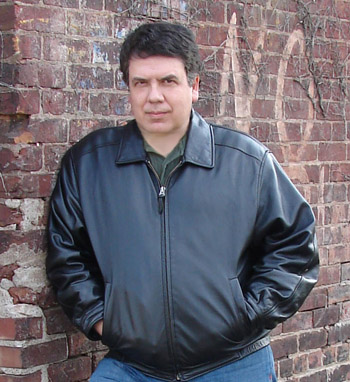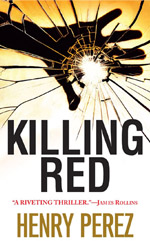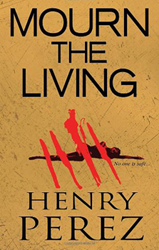 I’m very pleased to welcome author Henry Perez to Musings of an All Purpose Monkey in support of his latest release, Mourn the Living. I’ll be posting my review of Mourn the Living on Wednesday, but for now I’ll turn things over to Henry.
I’m very pleased to welcome author Henry Perez to Musings of an All Purpose Monkey in support of his latest release, Mourn the Living. I’ll be posting my review of Mourn the Living on Wednesday, but for now I’ll turn things over to Henry.
A couple of weeks ago at Bouchercon in San Francisco I had the opportunity to be on a panel titled Crazy Killers. That panel, which also included Steve Hockensmith, Marcus Sakey, Ken Mercer, and Rick Mofina, evolved into a lively discussion about character development.
It served as a perfect warm-up for this post about the process I go through when I’m writing a book and working on populating it with the sort of characters that readers will find interesting and memorable.
I don’t base my characters on anyone I’ve ever known. That sort of approach doesn’t interest me much, and it wouldn’t be anywhere near as much fun as it is to make them up out of whole cloth. When I began writing Killing Red, my debut thriller, I embraced two long-established theories of character development:
- The best protagonists are flawed.
- Every villain is the hero of his or her own story.
Alex Chapa, the protagonist of Killing Red and Mourn the Living, was born of a personal fascination with people who are very good at their jobs, but seemingly incapable of managing their everyday lives. We know all about these people in politics, sports, entertainment, business. We work with them every day, see them on the other side of the backyard fence, perhaps sit next to them at the Thanksgiving table.
In Chapa’s case, he is an exceptional newspaper reporter. Dedicated and resourceful, he launched his career more than a decade before we meet him, when he broke the story of the capture of Kenny Lee Grubb, the villain in Killing Red, then built it through years of tough and determined reporting.
 His personal life, on the other hand, is another matter. Chapa is divorced and bears a fair share of the blame for the failure of his marriage. His growing distance from his young daughter is a festering problem in Killing Red, and a major conflict that he must resolve in Mourn the Living. Chapa’s finances are a mess, as are his house and car. And the job he loves, as well as the industry that he’s sacrificed for and dedicated himself to serving, is slowly disappearing.
His personal life, on the other hand, is another matter. Chapa is divorced and bears a fair share of the blame for the failure of his marriage. His growing distance from his young daughter is a festering problem in Killing Red, and a major conflict that he must resolve in Mourn the Living. Chapa’s finances are a mess, as are his house and car. And the job he loves, as well as the industry that he’s sacrificed for and dedicated himself to serving, is slowly disappearing.
That, in a nutshell, is the guy my readers have to depend on to make things right. Chapa’s flaws not only add more hurdles for him to get over as he tracks the bad guys and pursues his story, they also help to make him a more real world character. This, of course, makes it easier for the reader to relate to him. Unless the protagonist is some sort of super human, detective, or spy, they should have a problem they need to solve, and it’s not the one that will drive the novel. In many ways, the main plot belongs to the villain. It is, after all, the antagonist who sets things into motion.
Antagonists can be a lot of fun to create, but the stakes are very high for an author. The villain can make or break a crime novel. For me, the antagonist begins as a product of the plot. I first know what the crime is, then I work backwards to create a profile of the sort of individual who would commit such an act. In a sense, that’s what every investigative reporter or police detective does. Though my readers will not get to know as much about my villains as they will about my protagonists, I do work to add depth to those characters as well. That’s vital in creating a compelling and genuinely threatening antagonist.
Villains should have a clear motivation for their crimes, and I tend to avoid the usual reasons (sex, money, power). A mindless villain can get boring in a hurry. So can a clichéd one. Each of the Alex Chapa thrillers contains flashback chapters that focus on the villain at a younger age. I don’t get into any sort of heavy psychoanalysis, but just as each of us is the product of our experiences, so it should be with our characters, including our villains.
Each of my books, Killing Red, Mourn the Living, as well as the two I’m working on now, have multiple antagonists. This helps add further complications to the plot. The key to this approach is that each villain needs to be distinct, and have their own individual set of motivations. Secondary and minor characters are, in their own way, every bit as essential to creating a vibrant and compelling narrative.
 One key to creating interesting minor characters is to avoid the sense that they did not exist until the moment when they first appeared on the page. For a minor character to make an impact they must be unique but credible, and they should have an implicit backstory. You may not fully know what each character’s personal history is, but the reader should get the sense that they have one. This can be achieved in a number of ways, through dialogue, appearance, or association.
One key to creating interesting minor characters is to avoid the sense that they did not exist until the moment when they first appeared on the page. For a minor character to make an impact they must be unique but credible, and they should have an implicit backstory. You may not fully know what each character’s personal history is, but the reader should get the sense that they have one. This can be achieved in a number of ways, through dialogue, appearance, or association.
Though minor characters are vital in creating a full, well rounded story, they have less weight to bear. This gives the author some room for invention. It’s with the minor characters that authors can experiment and take some chances. That makes these characters a great deal of fun to create. It can also make them memorable. I’ve gotten a great many comments about a bouncer with an attitude, a colorful psychic, and a savvy bar owner in Killing Red. The same is true for a would-be femme fatal, a befuddled rival newspaper reporter, and philosopher thief in Mourn the Living. These characters come and go, and the narrative moves on, but the impression that each of them makes can stay with readers for a long time.
Locations and settings can become characters as well. In fact, a well-crafted setting will take on a life of its own. I’ve received a number of emails and questions regarding a certain mobile home in Killing Red, and a windmill in Mourn the Living.
But now I’m wandering into the subject of settings, and that’s best left for another post.





Mourn the Living by Henry Perez | Musings Of An All Purpose Monkey*
November 3, 2010 - 11:19 AM